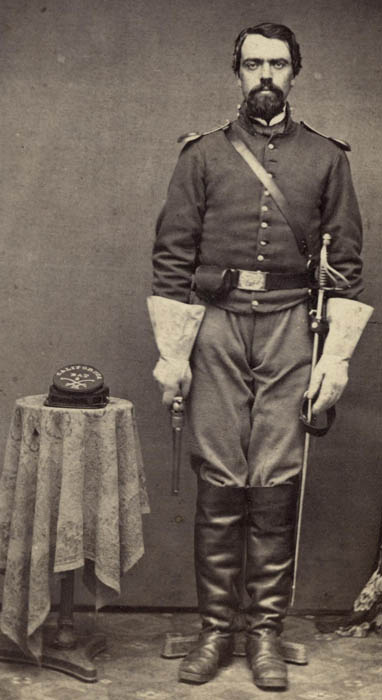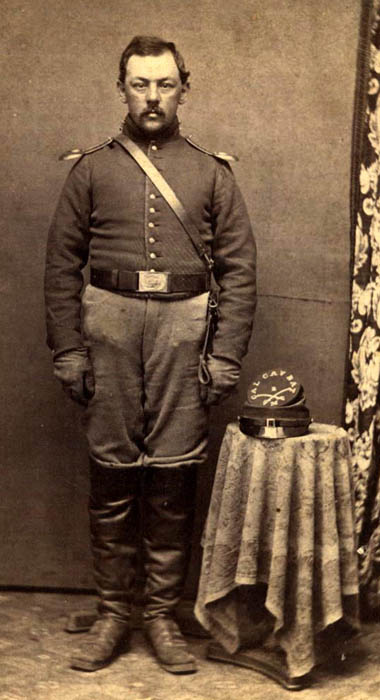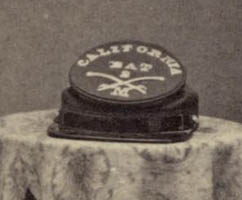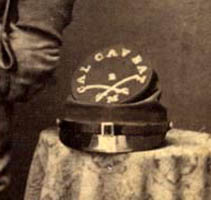Enlisted Uniforms
California Battalion Troopers
2nd Massachusetts Cavalry Regiment

Joseph H. Burke in Mounted Man's Jacket (Courtesy: Mike Sorenson) | 
James N. Eby in Mounted Man's Jacket (Courtesy: Mike Sorenson) |

Joseph H. Burke in Mounted Man's Jacket (Courtesy: Mike Sorenson) | 
James N. Eby in Mounted Man's Jacket (Courtesy: Mike Sorenson) |
Two unique units of the Civil War were the California Hundred and the California Battalion, which were part of the 2nd Massachusetts Cavalry. At the outbreak of the war certain individuals in California did not wish to join California state troops, who likely were to protect the frontier against Indians. They wanted to be in the eastern theater where they believed all the action would be. Arrangements were made with the governor of Massachusetts to accept these men as a unit into Massachusetts state forces and they became Company A of the 2nd Massachusetts Cavalry with the nickname "California Hundred."
Following them were a second group of 400 Californians, who became Companies E, F, L, and M of the 2nd Massachusetts and were referred to as the California Battalion. In general states were given a quota of volunteers to furnish and did not like their citizen serving with troops from another state. California was never given a quota, but none-the-less furnished over 15,000 troops to the Union cause. These were organized into eight infantry regiments, two cavalry regiments and several independent battalions.
Joseph H. Burke was an Irish born miner who was 27 when he enlisted as a private on January 30, 1863. On February 22, 1864 he was part of a detachment commanded by Captain Captain J. Sewall Reed and guided by the Confederate deserter, Charlie E. Binns, formerly of Company "A" 43rd Battalion Partisan Rangers, CSA. Unfortunately, the command fell victim to a classical ambush laid by John S. Mosby near Dranesville, Virginia. The Confederates fell on the troopers with such surprise and force that they had little chance to form a coordinated defence. Captain Reed shot and severely wounded Lieutenant Robert Baron von Massow of the Prussian Army, who had only recently been forwarded to Mosby's command by J.E.B. Stuart. Captain William H. Chapman, one of Mosby's company commanders, brought Reed down soon afterwards with a nearly point blank pistol shot. The now leaderless Federals were pressed from all sides and forced to surrender. Among men captured was Joseph Burke. Charlie Binns, the turn-coat scout and object of much hatred among the Confederates, managed his escape. Burke was ultimately sent to the infamous Andersonville Prison Camp in Georgia where he died July, 4 1864.
Joseph Burke's uniform consists of a cavalry jacket with attached shoulder scales. The jacket may have yellow branch color piping visible along the closure. However, there is evidence appearing in a soldier's memoir that members of the 2nd intentionally removed the yellow trim from their jackets. The motivation for doing this is uncertain, but it may reflect the attitude many infantrymen had that cavalrymen were not serious soldiers in their fanny jackets with the all the yellow trim. Over the jacket is his sword belt and shoulder sling, and saber. His light blue trousers are covered with knee length boots, which would have been privately purchased. Burke is also wearing a cap box on his sword belt, a pair of gauntlets and holding a pistol.
James N. Eby, a native of Pennsylvania, enlisted March, 20 1863 at the age of 29. He had been a telegrapher in Horsetown, Shasta Co. California. He was promoted steadily, first to corporal and finally to Commissary Sergeant, which is a responsible position within the regimental enlisted staff. In 1880 he was a merchant at Fort Thompson Indian Reservation in Dakota Territory. In 1890 he applied for a pension and was living in Illinois at the time. In 1900 he was a resident of the National Military Home in Marion, Grant Co., Indiana. In 1910 he was in the Danville, Vermilion Co., Illinois National Home Disabled Volunteer Soldiers.
James Eby's uniform is similar to Joseph H. Burke. They were in the same company and the photographer's props are the same suggesting that the photographs were taken at the same time and place. He is also wearing cavalry jacket with attached shoulder scales. The tips of the shoulder scales project out from the edge of the shoulder. This tendency of shoulder scales may have contributed to their lack of popularity. He is wearing a cavalry jacket with yellow piping visible along the closure. The inverted yellow "V" shaped trim usually seen at the base of the sleeve and the cuff buttons appear to be missing and may be another example of the 2nd Massachusetts troopers removing trim. Over the jacket is his sword belt and shoulder sling, but his saber is not present. He is wearing gloves. His boots are identical to Burke's.

Details of Burke's Kepi (Courtesy: Mike Sorenson) | 
Details of Eby's Kepi (Courtesy: Mike Sorenson) |
Members of these California units had among the most interesting forage cap (kepi) decoration in the Union Army. The colonel at some point ordered that these letters be removed as they did not contribute to cohesiveness between the California and Massachusetts troopers in the regiment. The letters appear to be of the "Zouave" style and could be privately purchased from sutlers. The distinctive crossed sabers were not of an issued type and were also privately purchased. The kepi insignia was clearly an individual act of the soldiers since they used different letters to indicate membership in the California Battalion. A published example of a forage cap worn by a member of the California Hundred (Company A of the 2nd Massachusetts Cavalry) also show they wore unique numbers and letters such as "CAL 100" on their forage caps (see Charles L. Hill's Private Robert M. Parker of the California Hundred, 1963 Military Collector and Historian XXIII(2): 61, Summer 1971).
The two caps illustrate two variations of period kepi styles with respect to the visor. Burke's has a flat visor and Eby's slopes downward and is of a type commonly called a McDowell style forage cap.